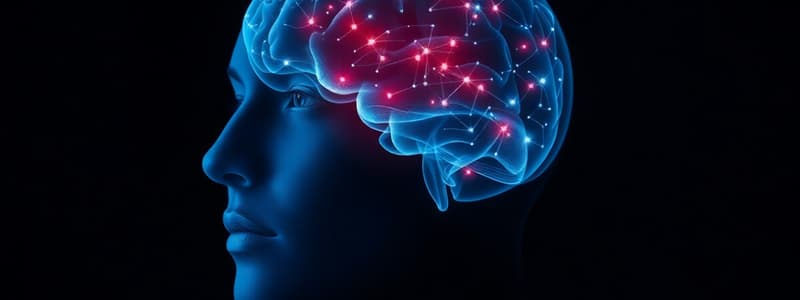Podcast
Questions and Answers
What occurs if there is no stimulation during the critical period for vision development?
What occurs if there is no stimulation during the critical period for vision development?
Why do individuals often find it challenging to adjust after regaining vision later in life?
Why do individuals often find it challenging to adjust after regaining vision later in life?
What is perceptual adaptation?
What is perceptual adaptation?
What does the term 'transduction' refer to in the context of vision?
What does the term 'transduction' refer to in the context of vision?
Signup and view all the answers
What defines a perceptual set?
What defines a perceptual set?
Signup and view all the answers
Which part of the eye is responsible for controlling the size of the pupil?
Which part of the eye is responsible for controlling the size of the pupil?
Signup and view all the answers
How can context influence perceptions?
How can context influence perceptions?
Signup and view all the answers
What is a primary cause of nearsightedness?
What is a primary cause of nearsightedness?
Signup and view all the answers
How does sensory adaptation work?
How does sensory adaptation work?
Signup and view all the answers
What is the role of the cornea in the eye?
What is the role of the cornea in the eye?
Signup and view all the answers
Which statement correctly describes cataracts?
Which statement correctly describes cataracts?
Signup and view all the answers
What specifically defines amplitude in the context of light waves?
What specifically defines amplitude in the context of light waves?
Signup and view all the answers
What is a common misconception about subliminal effects based on the experiment by Greenwald?
What is a common misconception about subliminal effects based on the experiment by Greenwald?
Signup and view all the answers
What is the primary cause of conduction hearing loss?
What is the primary cause of conduction hearing loss?
Signup and view all the answers
Which theory of pitch detection is supported by the idea that elderly people struggle to hear high pitched sounds?
Which theory of pitch detection is supported by the idea that elderly people struggle to hear high pitched sounds?
Signup and view all the answers
What function does a cochlear implant primarily serve?
What function does a cochlear implant primarily serve?
Signup and view all the answers
What is the purpose of Gate Control Theory in relation to pain perception?
What is the purpose of Gate Control Theory in relation to pain perception?
Signup and view all the answers
What sensation is not detected by our skin according to the content?
What sensation is not detected by our skin according to the content?
Signup and view all the answers
Which of the following sensations is associated with detecting sodium?
Which of the following sensations is associated with detecting sodium?
Signup and view all the answers
What phenomenon describes the brain interpreting pain without normal sensory input?
What phenomenon describes the brain interpreting pain without normal sensory input?
Signup and view all the answers
What sensory experience does the Rubber Hand Illusion primarily explain?
What sensory experience does the Rubber Hand Illusion primarily explain?
Signup and view all the answers
What does the opponent-process theory explain about color perception?
What does the opponent-process theory explain about color perception?
Signup and view all the answers
How do the three regions of the ear work together to process sound?
How do the three regions of the ear work together to process sound?
Signup and view all the answers
Which theory suggests that pitch perception is based on the location of stimulation in the cochlea?
Which theory suggests that pitch perception is based on the location of stimulation in the cochlea?
Signup and view all the answers
What role do hair cells play in hearing?
What role do hair cells play in hearing?
Signup and view all the answers
Why does our voice sound different when recorded compared to how we hear it while speaking?
Why does our voice sound different when recorded compared to how we hear it while speaking?
Signup and view all the answers
What factors determine the loudness of sound?
What factors determine the loudness of sound?
Signup and view all the answers
Which of the following is an implication of the frequency theory of pitch detection?
Which of the following is an implication of the frequency theory of pitch detection?
Signup and view all the answers
What is the purpose of the cochlea in the auditory system?
What is the purpose of the cochlea in the auditory system?
Signup and view all the answers
What is the primary distinction between sensation and perception?
What is the primary distinction between sensation and perception?
Signup and view all the answers
Which of the following best describes bottom-up processing?
Which of the following best describes bottom-up processing?
Signup and view all the answers
What is the absolute threshold in the context of sensation?
What is the absolute threshold in the context of sensation?
Signup and view all the answers
What does Weber's Law state regarding the difference threshold?
What does Weber's Law state regarding the difference threshold?
Signup and view all the answers
Which of the following influences our ability to detect stimuli according to signal detection theory?
Which of the following influences our ability to detect stimuli according to signal detection theory?
Signup and view all the answers
What is a characteristic of a false positive in perception?
What is a characteristic of a false positive in perception?
Signup and view all the answers
Why do some individuals dismiss the effectiveness of subliminal messages?
Why do some individuals dismiss the effectiveness of subliminal messages?
Signup and view all the answers
What is the main function of psychophysics?
What is the main function of psychophysics?
Signup and view all the answers
What principle explains why we may not notice changes in visual or auditory stimuli when focused on something else?
What principle explains why we may not notice changes in visual or auditory stimuli when focused on something else?
Signup and view all the answers
Which monocular depth cue involves perceiving smaller objects as being further away?
Which monocular depth cue involves perceiving smaller objects as being further away?
Signup and view all the answers
What kind of motion perception occurs when objects that appear stable seem to move as we do?
What kind of motion perception occurs when objects that appear stable seem to move as we do?
Signup and view all the answers
Which grouping principle refers to our tendency to perceive continuous patterns rather than disconnected ones?
Which grouping principle refers to our tendency to perceive continuous patterns rather than disconnected ones?
Signup and view all the answers
Which binocular cue involves the difference in images that the two eyes perceive due to their distance apart?
Which binocular cue involves the difference in images that the two eyes perceive due to their distance apart?
Signup and view all the answers
What is the term for the principle that allows us to perceive an object's size as constant despite changes in viewing distance?
What is the term for the principle that allows us to perceive an object's size as constant despite changes in viewing distance?
Signup and view all the answers
What phenomenon occurs when two or more adjacent lights blink in succession, creating an illusion of movement?
What phenomenon occurs when two or more adjacent lights blink in succession, creating an illusion of movement?
Signup and view all the answers
Which depth cue involves the understanding that if one object blocks another, the blocked object is perceived as being further away?
Which depth cue involves the understanding that if one object blocks another, the blocked object is perceived as being further away?
Signup and view all the answers
How do newly restored vision patients typically recognize faces differently compared to those with normal vision?
How do newly restored vision patients typically recognize faces differently compared to those with normal vision?
Signup and view all the answers
Which of the following cues indicates that clearer objects are closer and hazier objects are further away?
Which of the following cues indicates that clearer objects are closer and hazier objects are further away?
Signup and view all the answers
Study Notes
Sensation and Perception
- Sensation is the process of sensory receptors receiving information from stimuli
- Perception is the process of organizing sensory images into meaningful images
- Bottom-up processing uses sensory analysis of smaller pieces
- Top-down processing uses past experience and expectations
Thresholds
- Psychophysics studies the relationship between stimulus intensity and experience
- Absolute threshold is the minimum stimulation needed to detect a sensation 50% of the time
Signal Detection Theory
- Predicts how/when we detect faint stimuli among background noise
- Factors influencing detection include motivation, expectation, and experience
- False positive: perceiving a stimulus that isn't there
- False negative: failing to perceive a stimulus that is there
Difference Thresholds
- Difference threshold is the minimum difference between two stimuli for detection 50% of the time (just noticeable difference)
- Weber's Law states that for stimuli to be perceived as different, they must differ by a constant minimum percentage, not a constant amount. This percentage differs for different types of stimuli
Subliminal Messages
- Subliminal messages are below the threshold of conscious awareness
- May influence behavior, but their effectiveness is debated.
Sensory Adaptation
- Sensory adaptation is the ability of the senses to adjust to unchanging stimuli over time.
- Our senses fade into fragments, but our minds try to create meaning from these fragments.
- Transduction is the process of converting stimulus energies into neural messages.
Visual System
- Wavelength is the distance from one peak of a wave to the next and determines hue (color).
- Amplitude is the wave's height and determines the intensity (brightness).
- Frequency is the number of complete wavelengths that pass a point in a given time.
- Cornea, pupil, iris, lens, and retina are all important parts of the eye.
Visual Distortions
- Nearsightedness: inability of the eye to focus on distant objects
- Farsightedness: inability of the eye to focus on close objects
- Astigmatism: uneven curvature of the cornea or lens causing blurred vision
- Rods and cones are photoreceptor cells that detect light.
- Rods are more numerous, sensitive to low light, and do not distinguish color well.
- Cones are less numerous, less sensitive to low light, and are responsible for color vision.
- Blind spot is the area in the retina where the optic nerve leaves the eye and there are no receptors.
Audition
- Loudness is determined by a wave's amplitude (strength).
- Pitch is determined by a wave's frequency (number of cycles per unit of time).
- Decibels measure sound energy.
- Outer ear, middle ear, and inner ear convert sound waves into neural activity.
- Hair cells in the inner ear detect movement and send messages to the brain. (Cochlea)
Theories on Pitch Detection
- Place theory suggests we perceive pitch depending on where the cochlea's membrane is stimulated.
- Frequency theory suggests we perceive pitch based on the frequency of the sound wave traveling up the auditory nerve. (volley principle)
Hearing Loss
- Conduction hearing loss involves damage to the middle ear.
- Sensorineural hearing loss involves damage to the inner ear or auditory pathways.
Touch
- The skin detects warmth, cold, pressure, and pain.
- Pain is a multi-faceted sensation with different types such as; sharp, burning, throbbing, aching.
Body Position and Movement
- Vestibular sense helps detect head position and body movement
- Semicircular canals in the inner ear detect fluid movement.
Grouping Principles
- We group like things together;
- Proximity
- Similarity
- Continuity
- Closure.
- Other cues;
- Binocular cues
- Retinal disparity.
- Monocular cues
- Relative size
- Interposition
- Relative clarity
- Texture gradients
- Relative height
- Relative motion (motion parallax)
- Linear perspective
- Light and shadow
Perceptual Consistency
- Constancy is our tendency to perceive objects as unchanging even with changes to their retinal images
- Size
- Shape
- Brightness.
Perceptual Set
- A mental predisposition to perceive one thing over another, often influencing how we interpret sensory information
- Context effects
- Schematic effects
- Perceptual adaptation
- How we perceive things depends on our past experiences
Other Important Topics
- Sensory deprivation and how our brain adapts
- Practical implications of sensory processes.
- Subjective colors - occur when our brain creates a color that isn't actually there
- McGurk effect - when sight and sound together trick our brains into hearing something different from what is occurring.
Studying That Suits You
Use AI to generate personalized quizzes and flashcards to suit your learning preferences.
Related Documents
Description
Explore the fascinating world of sensation and perception in psychology through this quiz. Gain insights into how we detect and interpret stimuli, including essential concepts like thresholds and signal detection theory. Challenge yourself with key principles such as bottom-up and top-down processing and Weber's Law.




